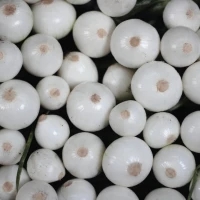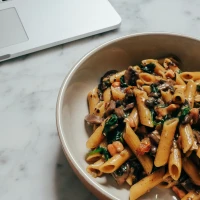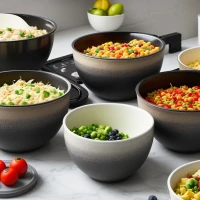In the realm of comfort food, French onion soup stands out as a testament to the timeless amalgamation of simple ingredients transforming into something extraordinary. As we delve into this dish’s rich history and indulge in its layers of flavor, there’s one element that’s as crucial to the experience as the soup itself—the vintage French onion soup bowls. These aren’t mere vessels; they’re the keys to unlocking a full, authentic encounter with this classic recipe.
In a world flooded with fleeting trends and culinary fads, there’s something profoundly grounding about returning to the essentials. Vintage French onion soup bowls represent far more than just a piece of kitchenware; they’re emblematic of an era when craftsmanship and attention to detail reigned supreme in the culinary world. With their distinctive designs and enduring quality, these bowls epitomize the essence of bowl food culture, inviting diners to rediscover their love for one of France’s most renowned gastronomic delights.
Unveiling the Charm of Vintage Bowls
The allure of vintage is not a happenstance; it’s woven into the very fabric of our appreciation for history and quality. Vintage French onion soup microwavable stouffers bowls carry with them the stories of countless family dinners, romantic evenings, and soul-warming comfort during chilly nights.
What Sets Vintage Bowls Apart
Vintage French onion soup half baked harvest salmon bowls possess unique characteristics that set them apart from their modern counterparts:
- Durability: Made from high-grade ceramics or porcelain, vintage bowls were crafted to last, surviving the test of time admirably.
- Design: The intricate patterns or simple elegance of these bowls bring charm to any table setting.
- Heat Retention: Quality materials ensure excellent heat retention, keeping the soup hot and flavorful.
Selecting the Perfect Vintage Bowl
When choosing the right vintage French onion soup bowl, consider the following features:
- Material: Stoneware, porcelain, or earthenware? Each offers its own benefits regarding heat retention and durability.
- Size: It should be ample enough for a generous serving, but not too large that it overwhelms the presentation.
- Handle and Lid: Some vintage bowls come with handles or lids—ideal for handling and keeping the soup warm.
A Recipe Wrapped in History
The tale of French onion soup is as layered as its flavors, dating back to Roman times. It evolved from humble beginnings, a simple broth for workers, into a culinary icon.
The Evolution of French Onion Soup
- Roman Roots: Originating as a basic broth for Roman laborers, the soup utilized readily available onions and old bread.
- Parisian Pedigree: The introduction of meat stock elevated the soup to a staple in Parisian markets and eventually fine dining establishments.
The Quintessence of ‘Bowl Food’
French onion soup exemplifies the concept of ‘bowl food’. The dish’s essence is the harmony of textures crate and barrel salad bowl temperatures—the crunch of the toasted bread, the stringy melted cheese, the comforting warmth of the onion broth—all culminating in a single vessel.
Crafting the Quintessential French Onion Soup
Creating the perfect French onion soup is an exercise in patience and precision. Here’s a step-by-step guide to crafting this age-old recipe.
Ingredients You Will Need
- Yellow Onions: The star of the show, sliced thin and caramelized to perfection.
- Beef Stock: A robust, flavorful base that sets the stage for the onions.
- Crusty Bread: A slice of baguette, toasted to act as the ideal sponge for the savory broth.
- Gruyère Cheese: For that iconic, gooey melted top layer.
The Art of Caramelization
Carabowl me over recipeslizing onions is the cornerstone of this dish. The process is slow—requiring vigilance and a low heat—allowing the natural sugars to develop complexity and depth.
Assembling the Layers
Layering the ingredients carefully is the key to achieving the signature gratinee:
- Bread: A toasted slice at the bottom of the bowl acts as the base.
- Broth: Ladle the onion-laden beef stock over the bread, immersing it.
- Cheese: A generous helping of Gruyère is sprinkled atop the soup before broiling.
The Role of Vintage Bowls in Serving
The right bowl transcends mere functionality, it elevates the entire dining experience.
Heat Endurance
Vintage French onion soup bowls are made to withstand the oven’s broiling heat—ensuring the cheese achieves that desired golden brown crust without compromising the bowl’s integrity.
Aesthetic Appeal
With these bowls, aesthetic appeal is not an afterthought. It’s an integral part of the dining ritual, enhancing not only the taste but also the visual and tactile enjoyment of the meal.
Tablescape Harmony
Integrating vintage French onion soup bowls into your tablescape adds a layer of authenticity and nostalgia, creating a warm atmosphere that complements the rich history of the soup itself.
Where to Find Vintage French Onion Soup Bowls
Embarking on a quest for vintage French onion soup bowls can be an enriching journey, leading to antique shops, estate sales, and online marketplaces.
Tips for Collectors
- Authenticity: Look for marks or stamps that authenticate the bowl’s date and place of origin.
- Condition: Check for cracks, chips, and wear that could affect the bowl’s durability and appearance.
- Variety: Embrace the diversity of designs and materials, from rustic earthenware to delicate porcelain.
Pairings and Complements: Elevating Your Soup Experience
Pairing your French onion soup with the right beverage and sides can transform a simple meal into a gourmet experience.
Wine Pairings
A medium-bodied red wine or a dry white wine can both complement the rich flavors and cut through the cheese’s richness.
Side Dishes
A light salad with a vinaigrette dressing or a plate of charcuterie can provide a refreshing counterbalance to the soup’s heaviness.
Garnishes for Flair
Final touches such as a sprig of fresh thyme or a dash of paprika can add a burst of color and flavor to your presentation.
Conclusion: Embrace the Timelessness of Vintage Bowls
There’s an undeniable draw to items that tell a story, and vintage French onion soup bowls are rich with narratives waiting to be shared around the dining table. As you seek out these charming relics, bear in mind that you’re not just acquiring a piece of kitchenware. You’re inheriting a segment of culinary history, a reminder of the elegance that once graced tables with every serving of this hearty ‘bowl food’ staple.
Rediscovering the joy of French onion soup, served in beautiful vintage bowls, is more than just a nod to tradition. It’s an invitation to create new memories while honoring the past and savoring the seamless blend of flavors and textures that have resonated through generations.
By integrating vintage French onion soup bowls into your kitchen repertoire, you’re not just setting the stage for a delicious dish—you’re contributing to the legacy of bowl food, rekindling a love for the rustic yet refined, and ensuring that the elegance of yesteryear continues to bring warmth to tables for years to come.










